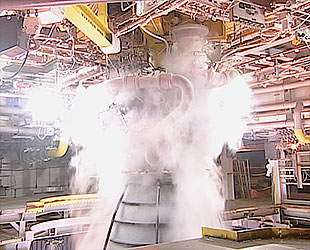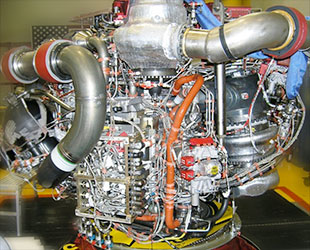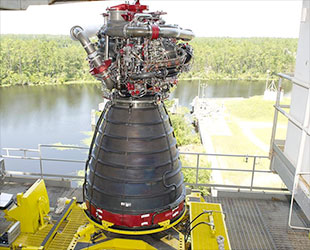Jan. 12, 2015 — For the first time in more than three-and-a-half years, a space shuttle main engine roared to life on Friday (Jan. 9) in support of NASA's new heavy-lift rocket.
The space shuttle main engine (SSME), now renamed the RS-25D, fired for 500 seconds atop the A-1 test stand at NASA's Stennis Space Center in Mississippi. The first fire of a former-SSME since the final shuttle launch in 2011, Friday's test was the first RS-25D hot fire since the end of shuttle engine testing in 2009.
Four RS-25 engines are planned to power the first stage of NASA's Space Launch System (SLS) on future missions, including sending astronauts to an asteroid and ultimately to Mars. The first uncrewed SLS test flight is targeted for 2018.
"The RS-25 is the most efficient engine of its type in the world," said Steve Wofford, the manager of the SLS liquid engines office at NASA's Marshall Space Flight Center in Huntsville, Ala., where the SLS program is managed. "It's got a remarkable history of success and great experience base that make it a great choice for NASA's next era of exploration."

Close-up view of the A-1 test stand during the RS-25 test. (NASA) |
Three RS-25 engines were mounted to the rear of each shuttle orbiter to power the vehicle through its ascent and initial entry into orbit. On the shuttle, each of the engines routinely operated at 491,000 pounds of thrust. On SLS, they will need to each operate at 512,000 pounds of thrust (on at least the first four flights) and handle colder liquid oxygen propellant and engine compartment temperatures.
"We have made modifications to the RS-25 to meet SLS specifications," Wofford said, "and will analyze and test a variety of conditions during the hot fire series."
In addition to increased thrust and temperatures, the RS-25 engines used on the SLS will encounter greater inlet pressure due to the taller core stage liquid oxygen tank and higher vehicle acceleration, as well as more nozzle heating due to the engine configuration and their position in-plane with the SLS booster exhaust nozzles, according to Wofford.
Friday's test fire collected data on the engine's controller unit and inlet pressure conditions.
The engine controller unit, the "brain" of the engine, relays commands to the engine and transmits data back to the launch vehicle. The controller also manages the engine by regulating the thrust and fuel mixture ratio while monitoring the engine's health and status.

RS-25 engine controller unit, the "brain" of the engine. (NASA) |
The RS-25's new controller will use updated hardware and software configured to operate with the new SLS avionics architecture.
"This first hot-fire test of the RS-25 engine represents a significant effort on behalf of Stennis Space Center's A-1 test team," Ronald Rigney, the RS-25 project manager at Stennis, said in a NASA statement. "Our technicians and engineers have been working diligently to design, modify and activate an extremely complex and capable facility in support of RS-25 engine testing."
Testing will resume in April after upgrades are completed on the test stand's high pressure industrial water system, which provides cool water for the test facility during a hot fire test.
The engine fired on Friday, no. 525, did not fly onboard a space shuttle orbiter. One of two development engines at Stennis, it'll be used for seven more tests before another development engine (no. 528) will later undergo ten tests. The second series of test firings will include the first tests of the new engine controller unit.

RS-25 rocket engine no. 0525 is positioned on the A-1 Test Stand at NASA's Stennis Space Center in Mississippi. (NASA) |
Fifteen flown RS-25D engines remained at the end of the shuttle program. Unlike on the shuttle, which returned the engines after each mission for reuse, the RS-25 engines will be discarded with each SLS launch.
"We had identified significant cost and time saving ideas for the RS-25 before the shuttle program ended," Wofford explained. "We see many opportunities for process and manufacturing savings with the change to an expendable engine and the maturation of technologies, such as 3D printing and structured light scanning."
NASA is planning to restart RS-25 production by working with its contractor Aerojet Rocketdyne to further adapt and modify the SSME design to be more affordable, while also increasing the planned thrust to 521,700 pounds.
According to NASA, the initial production order will be for six new engines once experience is gained with the design and manufacturing changes. With that, NASA expects the RS-25 to power its space exploration plans for many more decades, building upon the engine's shuttle legacy.
